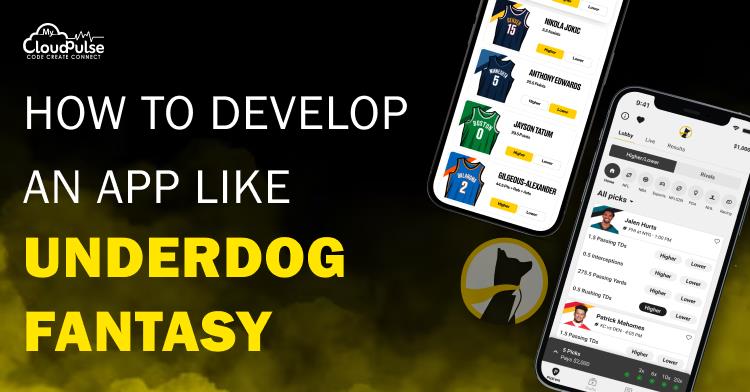A sea change has occurred in the fantasy sports scene. Drafts that last the whole season and unchanging rosters are things of the past. Daily and weekly fantasy tournaments, made possible by platforms like Underdog Fantasy, have given sports fans an exciting and interactive new way to enjoy their favorite pastime. Their creative strategy has attracted a large and devoted fan base, prioritizing easier draft forms and fast payments.
Do you want to take advantage of this flourishing market? Would you like to develop an App like Underdog Fantasy, similar in terms of simplicity and fun? If you want to know what it takes to make an app like Underdog Fantasy, this blog has you covered.
It covers the fundamental features, development stages, important technologies, and cost. Developing a platform that connects with today’s sports fans and provides them with an exciting new method to follow their favorite teams and athletes is something we’ll get into.
The Statistics of Underdog Fantasy
When it comes to daily fantasy sports (DFS), Underdog Fantasy has swiftly risen to the top. Its distinctive “Pick’em” games, in which users wager on whether certain players will exceed or fall short of their predicted statistics, set it apart from its 2020 launch. The streamlined approach has made fantasy sports more accessible to a larger audience than conventional salary cap drafts.
Underdog Fantasy goes beyond choose’em with their Best Ball drafts, a simplified model that players can utilize all season long. Players choose their teams, and each week, without any in-season administration, the ideal lineup is automatically determined. This is perfect for those who want to participate in drafting but don’t want to commit to making roster selections every week.
Underdog Fantasy has grown substantially, even if the exact number of users varies. Millions of people have reportedly interacted with the site, taking part in tournaments spanning many professional sports leagues. Their emphasis on user experience and creative contest formats has helped them grow quickly and become a formidable rival in the daily fantasy sports industry. Their achievements demonstrate the need for user-friendly and interesting fantasy sports websites.
What is the Mechanism of Underdog Fantasy?
Quick and exciting fantasy sports games are at the heart of Underdog Fantasy’s user-friendly experience. For the most part, this is how it works for users:
1. Install the App:
To begin, download the Underdog Fantasy app from your mobile device’s App Store (iOS) or Google Play (Android). The next step is for users to download the app on their mobile devices.
2. Join an Existing League or Form Your Own:
Users are required to sign up for an account the moment they launch the app. Members already have an account and may access their account information. After they’ve checked in, users may see all the different kinds of contests.
- Pick’em: In pick’em, players choose one player at a time to place prop bets on (for example, LeBron James above 25.5 points). For each player, they decide whether their performance will be “higher” or “lower” than the predicted number. The greater the number of accurate guesses, the higher the payout.
- Best Ball: Users may take part in a Best Ball draft and join existing leagues or start their own. There is no need to maintain the roster anymore when the draft is over. To calculate their score, the platform chooses the top scorers from their team every week.
- Other Formats: There are a variety of contest styles that Underdog Fantasy may provide, including single-game formats and challenges based on certain events.
3. Playing a Sport of Choice:
Contests for users’ favorite sports leagues are available for perusal. Upcoming competitions, entrance costs, prize pools, and participant counts are usually shown in the app. After choosing the competitions they want to participate in, users may either join a draft (in Best Ball) or choose their players (in choose’em).
4. Win and Review:
The software keeps track of the user’s contestants’ stats while the actual athletic events happen. At the end of each round, the results are confirmed, and the winners’ accounts are funded. The app allows users to see their performance history and examine prior contests.
Essential Elements of an Underdog Fantasy-Style App
If you want to build a fantasy sports software like Underdog Fantasy, you need to include some essential features. All of these elements work together to make the user experience smooth, interesting, and fun.
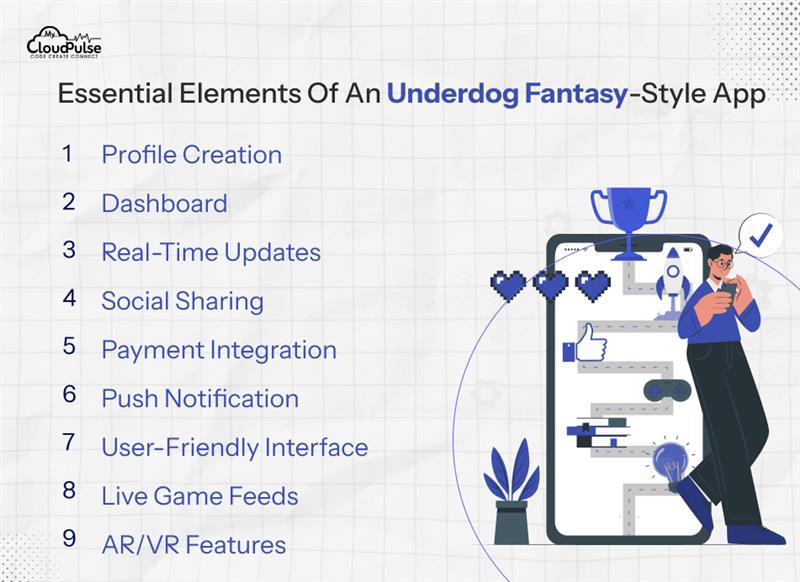
1. Profile Creation:
It is essential to have a user registration and login system that is both easy to use and secure when creating a profile. It would be great if users could set up profiles, edit their details, and maybe even connect their payment methods.
2. Dashboard:
Overview of current competitions, forthcoming games, account balances, transaction history, and tailored suggestions may be found on the dashboard. It has to make sure that the most important parts of the app are easily accessible.
3. Real-Time Updates:
For consumers to stay involved throughout games, it is essential to include real-time information such as scores and statistics. With this function, they may keep tabs on how their chosen players are doing and how they’re doing in the competition.
4. Social Sharing:
To promote organic user acquisition and create a feeling of community, users should be able to share their contest submissions and results with their friends on social networking networks.
5. Payment Integration:
Users must have safe and dependable integration with several payment channels to deposit cash, participate in competitions, and withdraw their wins without any hassle. The user experience is improved by offering a variety of payment methods.
6. Push Notification
User engagement may be greatly enhanced with timely and relevant push notifications. Among them, you may find announcements about forthcoming competitions, progress reports on individual players, contest results, and special deals.
7. User-Friendly Interface:
A favorable user experience is greatly enhanced by an interface that is both easy to use and aesthetically pleasing. To attract and keep users, it is vital to have a flexible design, easy navigation, and a clear information architecture.
8. Live Game Feeds
The integration of live game feeds improves the entire experience by letting users track the progress of real sports events inside the app. This gives context to player statistics.
9. AR/VR Features:
While augmented or virtual reality (AR/VR) features are not central to Underdog Fantasy at the moment, they have the potential to provide a unique and engaging experience along the road, such as virtual watch parties or interactive stat overlays.
How to Develop an App Like Underdog Fantasy
A well-organized process with several critical steps is required to develop a fantasy sports software such as Underdog Fantasy:
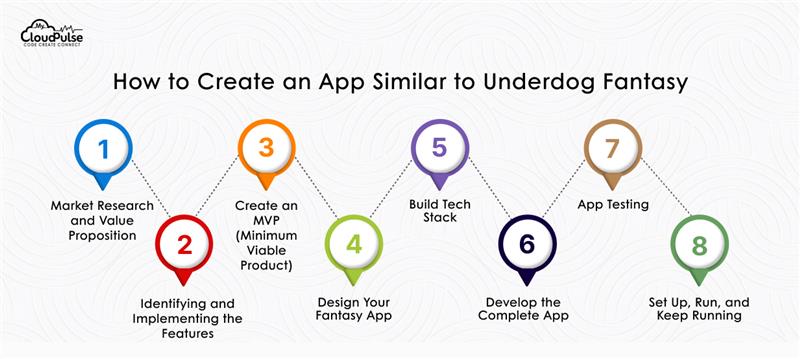
Step 1: Market Research and Value Proposition:
First, you need to perform some serious research into the industry to figure out who you’re up against, what your target audience wants, and how current platforms like Underdog Fantasy stack up. Identify the unique selling point (USP) of your software. Think of unconventional features, strange contest structures, or specialized sports.
Step 2: Identifying and Implementing the Features:
Create an exhaustive feature set for your app based on your value proposition and market research. Make sure the most important features, such as registering users, choosing contests, drafting and selecting players, scoring, and payment integration, work first. Consider scalability while making plans to add features in the future.
Step 3: Create an MVP (Minimum Viable Product):
Make a stripped-down version of your app that only has the functionality you absolutely must have. You can get your product out there fast, hear what people have to say, and then make improvements based on what people really use. Early adopters should get fundamental value from the functioning MVP.
Step 4: Design Your Fantasy App:
Think about how to make the design both aesthetically pleasing and easy to use. Making sure the UX is consistent and engaging across all devices, creating mockups of the UI, and wireframing the user flow are all part of this process.
Step 5: Build Tech Stack:
When building your app, be sure to choose the right technology. This requires selecting a database (PostgreSQL, MongoDB), a programming language (iOS’s Swift, Android’s Kotlin, or cross-platform React Native), a backend framework (Node.js, Python/Django, or Ruby on Rails), and a cloud hosting provider (iOS, Google Cloud, or Azure, for example).
Step 6: Develop the Complete App:
At this stage, your development team will construct the app according to the design requirements and the technology stack you’ve selected. This requires integrating application programming interfaces (APIs) for data feeds, payment gateways, and other features, as well as developing the user interface (front end) and back end (server side logic and database administration).
Step 7: App Testing
Finding and fixing issues, ensuring functionality, and optimizing performance all need rigorous testing. Among them, you may find performance testing, UAT, integration testing, and unit testing.
Step 8: Set Up, Run, and Keep Running:
Release your software to the software Store and the Google Play Store when testing is over. Get your product in front of the right people by planning its launch and promotion. To fix bugs, boost performance, and incorporate user input and market trends into new features, it is vital to continuously monitor, maintain, and upgrade the product after launch.
Essential Technologies for Develop an App like Underdog Fantasy
Your fantasy sports app’s performance, scalability, and maintainability are greatly affected by the technological stack. Some important technologies to think about are:
a. Development for Mobile Devices:
Develop natively using Swift for iOS or Kotlin for Android to take use of all the capabilities and run at your device’s best.
React Native and Flutter are examples of cross-platform frameworks that enable code sharing across several platforms, which might cut down on development costs and time.
b. Development of the Backend:
- Ruby on Rails with Express.js
- Combining Python with Flask or Django
- Rails and Ruby
- Using Spring with Java
c. Databases:
- Databases for Relationships: PostgreSQL and MySQL
- NoSQL Relational Databases: Cassandra, MongoDB

d. Cloud Hosting:
- The Website of Amazon (AWS)
- Google Cloud Platform (GCP)
- Microsoft Azure Cloud
e. Latest Updates:
- Secure WebSockets
- Pusher
- Firebase
f. Payment Gateways:
- Stripe
- The PayPal
- The Braintree
g. Push Notifications:
- Firebase Cloud
- Applications for Push Notifications (APNs) by Apple
h. Sports Data APIs:
- Tracker for Athletic Events
- Statistics Work
- TheScore Developer Platform
Considerations like development team experience, available funds, performance expectations, and scalability requirements will dictate the technology you choose.
What It Would Cost to Develop an App Like Underdog Fantasy?
There are a lot of moving parts that might affect how much it will cost to develop an app like Underdog Fantasy. Without knowing the particular parameters of the project, it is difficult to provide a precise estimate; nevertheless, we can describe the main factors that will affect the final price tag and give you a ballpark.
A budget of $50,000 to $150,000 could provide you with a minimum viable product (MVP) with the essentials. A more feature-rich, aesthetically pleasing, and cross-platform software may cost anywhere from one hundred thousand to five hundred thousand dollars or more. The exact cost may vary from these figures, which are just general approximations.
Factors Affecting to Develop an App Like Underdog Fantasy?
A fantasy sports app’s total development cost is affected by many important factors:
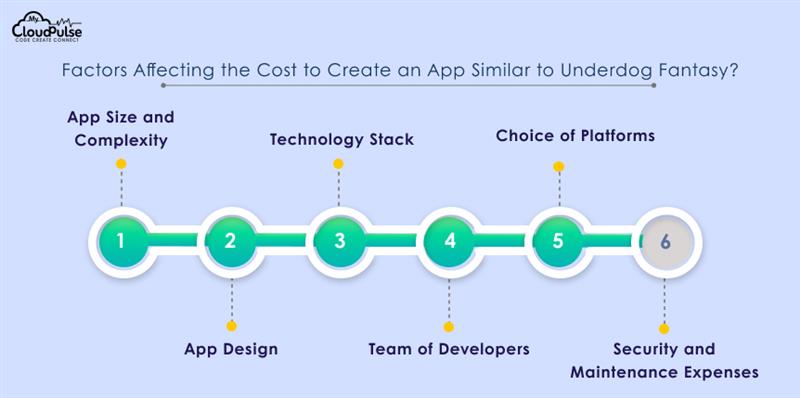
1. App Size and Complexity:
A vital part of app design is the visual design and user experience (UI/UX). Compared to a simple or templated design, the cost of a unique, aesthetically pleasing, and user-friendly one will be higher.
2. App Design:
The complexity and size of the app, as measured by the features and their implementation, have a direct bearing on the time and money needed for development. Additional time and resources are needed for the development of features and functions that are more complicated.
3. Technology Stack:
The cost might be impacted by the technology stack. Higher hourly charges may be necessary for specialist developers when working with certain technologies. Depending on the intricacy, cross-platform development may have restrictions, although it may occasionally be more cost-effective in the beginning.
4. Team of Developers:
The development team’s size and location have a substantial impact on the overall cost. A larger price tag is inevitable when you bring in seasoned programmers, designers, project managers, and quality assurance specialists. Because different locations have different rates of growth, geography is another factor.
5. Choice of Platforms:
It is often more costly to design an app that is native to both iOS and Android rather than creating an app that works across both platforms.
6. Security and Maintenance Expenses:
It is necessary to include the expenses of implementing strong security measures as well as continuing maintenance, bug fixes, updates, and server charges into the total budget.
Challenges in Building an App Similar to Underdog Fantasy
There are unique obstacles to overcome in creating a popular fantasy sports software such as Underdog Fantasy:
a. Legal Compliance Issues:
The legal requirements for fantasy sports and online gambling may be complex, which can lead to issues with compliance. Avoiding legal trouble requires careful attention to regulations, which differ by jurisdiction.
b. Poor App Design Interface:
An inefficient or confusing user interface in an app might cause users to get frustrated and eventually uninstall the app. To keep users coming back, you need to put money into an interface that is easy to use and well-designed.
c. Lack of User Engagement:
The importance of maintaining user engagement cannot be overstated in a highly competitive industry. User engagement may decrease in the absence of appealing features, interesting material, and successful methods of establishing communities.
d. Overbuilding of Features:
The software might become bloated and confused if too many features are attempted to be included all at once. It is usually more effective to concentrate on essential features and add them incrementally according to user input.
e. Improper Market Research:
An app that doesn’t connect with customers or stand out successfully might be the result of inadequate market research, which involves not fully comprehending the target demographic and the competitive environment.
How to Make Money by Develop an App Like Underdog Fantasy?
Insights for your platform may be gained by studying the monetization tactics of popular applications such as Underdog Fantasy:
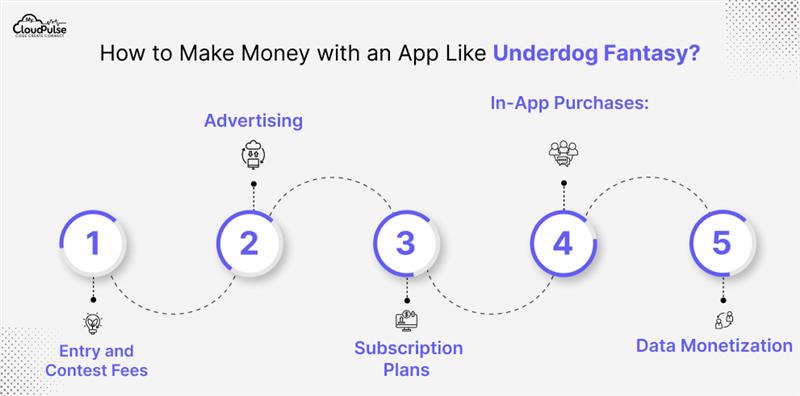
1. Entry and Contest Fees:
The majority of daily fantasy sports platforms get their money from contest entry fees. The prize pool is funded by a fraction of the overall entry costs, while the platform keeps the rest as income.
2. Advertising:
Personalized app ads may bring in some extra cash, even if they aren’t usually the main source.
3. Subscription Plans:
One way to generate recurring money is by offering premium subscription levels that come with special features, bonuses, or improved analytics.
4. In-App Purchases:
You may generate cash via in-app purchases, which allow users to buy optional boosts or cosmetic upgrades.
5. Data Monetization:
While privacy concerns must always take precedence, data monetization presents an opportunity for collaborations and market research, including aggregated and anonymized user data.
How MyCloudPulse Helps You Develop an App Like Underdog?
If you’re thinking of creating a fantasy sports app similar to Underdog Fantasy, MyCloudPulse can assist you with all aspects of app development. At each point in the development process, our seasoned staff is here to help you out, including:
1. Market Research and Strategy:
We can assist you in assessing the market, determining your ideal customers, and developing a compelling value offer.
2. UI/UX Design:
Our talented designers will craft a user interface and experience that is easy to use, aesthetically pleasing, and captivating.
3. Mobile App Development:
Whether you need an app for iOS or Android, our professional developers can provide a solid and scalable solution.

4. Back-end development:
We will build a reliable and efficient backend system to support your app’s features.
5. API Integration:
The application programming interfaces (APIs) required to connect sports data, payment gateways, and push alerts may be easily implemented by our team.
6. Testing & Quality Assurance:
Our QA team will test your app extensively to find and fix any bugs and make sure it runs well.
7. Deployment and Maintenance:
We provide continuous support and maintenance in addition to assisting with app launches to app marketplaces.
If you want to build a fantasy sports platform but aren’t sure where to start, partnering with MyCloudPulse can provide you with the technical knowledge and direction you need.
Frequently Asked Questions:
Answer: The intricacy and breadth of the project determine the development schedule. A minimum viable product (MVP) with few features may be ready in 6–9 months, but a full-featured software might take 12–18 months or more.
Answer: Data privacy laws, terms of service, and local rules about online gambling and fantasy sports are among the legal factors to think about. To make sure your software doesn’t break any laws, it’s important to talk to lawyers.
Answer: For user engagement, real-time data integration is crucial. Users can’t keep up with their contest progress or lose interest in the games without live score updates and real-time data.
Answer: Marketing campaigns that are well-targeted, generous welcome bonuses and promotions, contest forms that are both entertaining and challenging, community building, and constant iteration based on user input are all part of the strategy.
Answer: Securing user identification, encrypting data, safeguarding against cheating and fraud, processing payments securely, and adhering to applicable data security standards are all essential security procedures.
If you want to build a platform that sports fans will love, you need to study up on the fantasy sports industry, look at what makes applications like Underdog Fantasy tick, and learn how to code. To make your concept a reality, keep in mind to put the user first, concentrate on innovation, and team up with seasoned experts.
